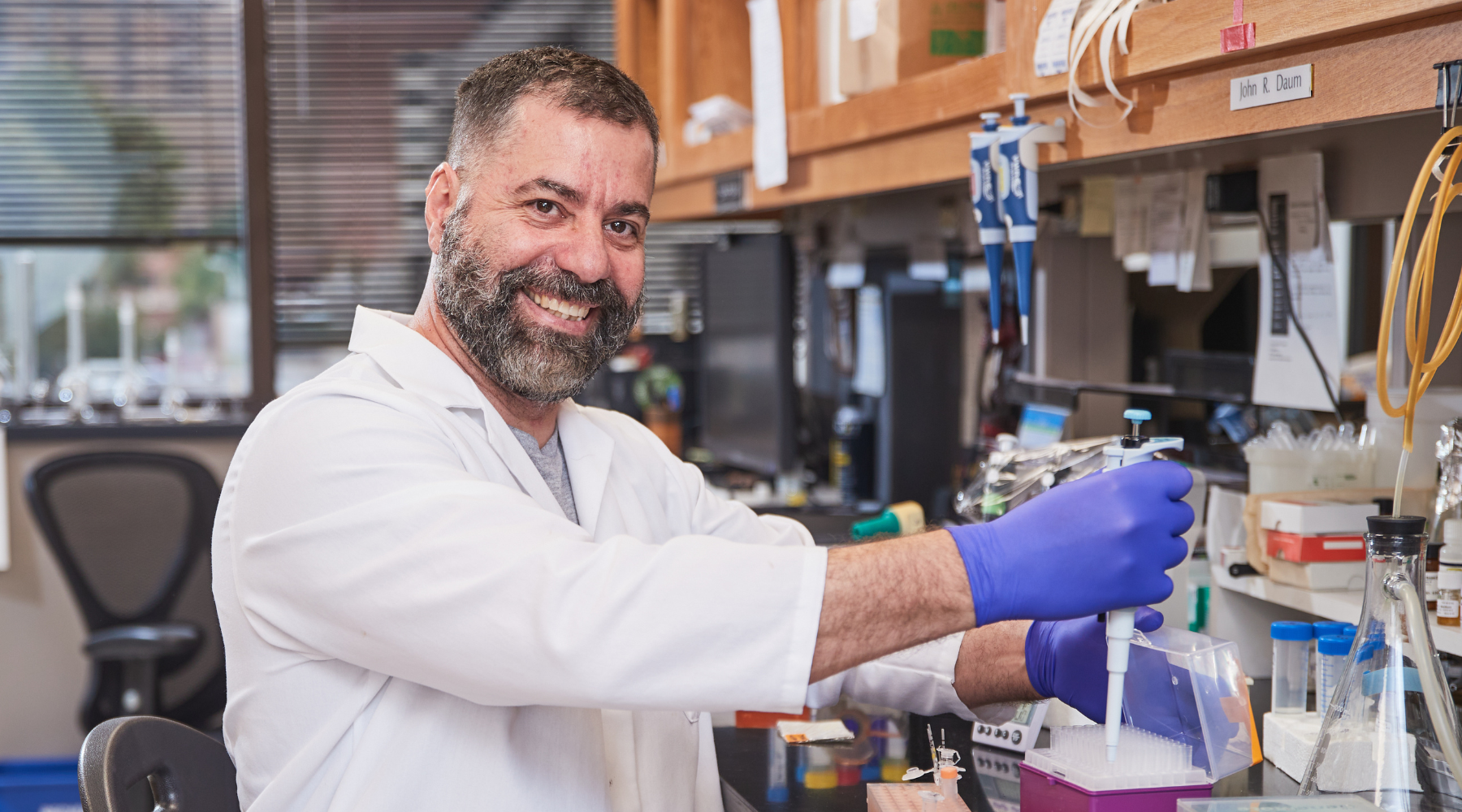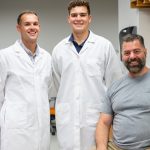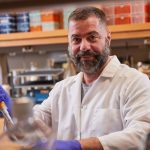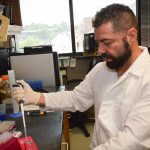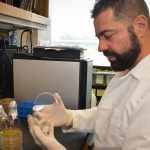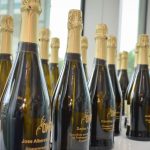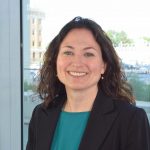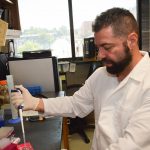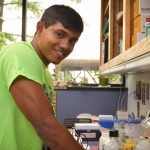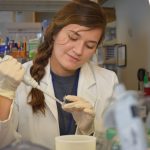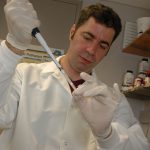Roberto Jose Pezza, Ph.D.
Associate Professor
Cell Cycle & Cancer Biology Research Program
My 101
Everybody knows you can break your arm, but most people are unaware that you can break your DNA, too. And fewer still know that DNA can be repaired.
Deoxyribonucleic acid, or DNA, is a string of four different chemicals that make up the library of you. The order of chemicals in your DNA is the determining factor in the color of your hair, how tall you can grow and how your body makes proteins and other chemicals. And you don’t just have one piece of DNA – there’s a copy in almost every cell in your body.
Damage to DNA can cause or contribute to a number of diseases, and in my lab, we’re studying how breaks and repairs at different points in life can affect health. DNA that is cut or malformed in the embryonic stage can cause birth defects and lead to Down syndrome or Turner syndrome. If DNA is damaged after birth, it can sometimes cause cancer.
We’re studying a system that repairs a specific kind of DNA cut and how some repairs are good and others cause problems. By understanding how the system works, we hope to better diagnose disease and find ways to treat or prevent birth defects and some kinds of cancer.
Research
Chromosome aneuploidies are the leading cause of infertility and birth defects in humans. They result from errors in the segregation of homologous chromosomes (HCs) during gametogenesis. The proper segregation of chromosomes is ensured by meiotic homolog recombination (HR). It begins with the introduction of DNA double-strand breaks (DSBs) followed by their repair using the intact DNA of a HCs as template. This leads to a temporal association of the HCs in pairs that ensures their orderly segregation to opposite poles of dividing nuclei so that each gamete receives one (and only one) homolog of each pair. The homologs that fail to synapse segregate randomly, having 50% chances to go into the same daughter cell. Consequently, mutations that reduce or abolish recombination are invariably associated with gross abnormalities in chromosome segregation. An estimated 10 to 30% of fertilized human eggs have the wrong number of chromosomes resulting in at least 5% of conceptions being aneuploid. Most of them abort before term making aneuploidy the leading known cause of pregnancy loss. Those who survive face devastating consequences, including developmental disabilities and mental retardation.
The field of homologous recombination faces exciting challenges. One of the biggest tests will be to connect the dots between the biochemical function of proteins involved in HR and their in vivo role.
My laboratory studies the bases involved in the repair of DSBs and HCs synapses in mouse. We use a combination of different approaches ranging from the reconstruction of in vitro systems using purified proteins to the generation of genetically modified mice. Our goal is to uncover the fundamental molecular mechanisms regulating the process of homologous recognition and the proper segregation of HCs.
Brief CV
Education
B.S., National University of Cordoba, Argentina, 1997
M.S., National University of Cordoba, Argentina, 1997
Ph.D., National University of Cordoba, Argentina, 2002
Research Fellow, National Institutes of Health, Bethesda, MD, 2007-2009
Honors and Awards
Scholarship, National University of Cordoba, State of Cordoba Scientific Research Council, CONICOR, Argentina, 1997
Fellowship (for initial training in research), National Research Council, CONICET, Argentina, 1998-2000
Fellowship, National Research Council, CONICET, Argentina, 2000-2002
Research Excellence Award, National Universities and National Educational Council, Argentina, 2002-2004
Visiting Fellow, National Institutes of Health, Bethesda, MD, 2003-2007
Research Fellow, National Institutes of Health, 2007-2009
Fellows Award for Research Excellence, National Institutes of Health, Bethesda, MD, 2008
New Scientist Recruitment and Retention Award, Oklahoma Center for Advancement of Science and Technology, Oklahoma City, 2010-2013
J. Donald and Patricia H. Capra Award for Scientific Achievement, Oklahoma Medical Research Foundation, 2019
Joined OMRF scientific staff in 2009
Publications
Recent Publications
Castell SD, Fernandez CM, Tumas IN, Margara LM, Miserendino MC, Ceschin DG, Pezza RJ, Monti MR. The low-fidelity DNA Pol IV accelerates evolution of pathogenicity genes in Pseudomonas aeruginosa. Commun Biol 8:1148, 2025 August, PMID: 40753298, PMCID: PMC12318082
Carbajal A, Gryniuk I, de Castro RO, Pezza RJ. Efficient Enrichment of Synchronized Mouse Spermatocytes Suitable for Genome-Wide Analysis. Methods Mol Biol 2818:65-80, 2024 January, PMID: 39126467
de Almeida LP, Lee CY, Carbajal A, de Castro RO, Pezza RJ. Visualization and Quantification of Rapid Chromosome Movements at Early Stages of Mouse Meiosis. Methods Mol Biol 2818:171-177, 2024 January, PMID: 39126474, PMCID: PMC12207911
Selected Publications
Lee CY, Bisig CG, Conrad MM, Ditamo Y, Previato de Almeida L, Dresser ME, Pezza RJ. Extranuclear Structural Components that Mediate Dynamic Chromosome Movements in Yeast Meiosis. Curr Biol. 2020 Apr 6;30(7):1207-1216.e4. doi: 10.1016/j.cub.2020.01.054. Epub 2020 Feb 13. PMID: 32059771, PMCID: PMC7181386
Previato de Almeida L, Evatt JM, Chuong HH, Kurdzo EL, Eyster CA, Gladstone MN, Gómez-H L, Llano E, Meyer R, Pendas AM, Pezza RJ, Dawson DS. Shugoshin protects centromere pairing and promotes segregation of nonexchange partner chromosomes in meiosis. Proc Natl Acad Sci U S A 116:9417-9422, 2019 May, PMID: 31019073, PMCID: PMC6511000
Guiraldelli MF, Felberg A, Almeida LP, Parikh A, de Castro RO, Pezza RJ. SHOC1 is a ERCC4-(HhH)2-like protein, integral to the formation of crossover recombination intermediates during mammalian meiosis. PLoS Genet. 2018 May 9;14(5):e1007381. eCollection 2018 May. PMID: 29742103 PMCID: PMC5962103
Rao HB, Qiao H, Bhatt SK, Bailey LR, Tran HD, Bourne SL, Qiu W, Deshpande A, Sharma AN, Beebout CJ, Pezza RJ, Hunter N. A SUMO-ubiquitin relay recruits proteasomes to chromosome axes to regulate meiotic recombination. Science. 2017 Jan 27;355(6323):403-407. doi: 10.1126/science.aaf6407. Epub 2017 Jan 5. PMID: 28059716, PMCID: PMC5569317
de Castro RO, Previato L, Goitea V, Felberg A, Guiraldelli MF, Filiberti A, Pezza RJ. The chromatin-remodeling subunit Baf200 promotes homology-directed DNA repair and regulates distinct chromatin-remodeling complexes. J Biol Chem. 2017 May 19;292(20):8459-8471. Epub 2017 Apr 5. PMID: 28381560 PMCID: PMC5437250
Lee CY, Horn HF, Stewart CL, Burke B, Bolcun-Filas E, Schimenti JC, Dresser ME, Pezza RJ. Mechanism and regulation of rapid telomere prophase movements in mouse meiotic chromosomes. Cell Rep. 2015 Apr 28;11(4):551-63. Epub 2015 Apr 16. PMID: 25892231 PMCID: PMC4417006
Contact
Cell Cycle and Cancer Biology Research Program, MS 48
Oklahoma Medical Research Foundation
825 N.E. 13th Street
Oklahoma City, OK 73104
Phone: (405) 271-6467
Fax: (405) 271-7312
E-mail: Roberto-Pezza@omrf.org
For media inquiries, please contact OMRF’s Office of Public Affairs at news@omrf.org.
Lab Staff
Marcin Ostoja-Helczynski
Research Technician I
Katarzyna Nowak
Research Technician I
Monika Kawecka
Graduate Student
Jase Daugherty
Administrative Assistant III
Denna Mills
Administrative Assistant III
